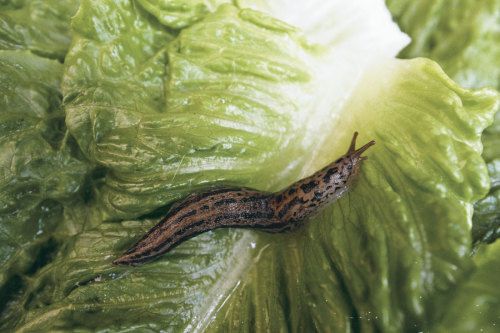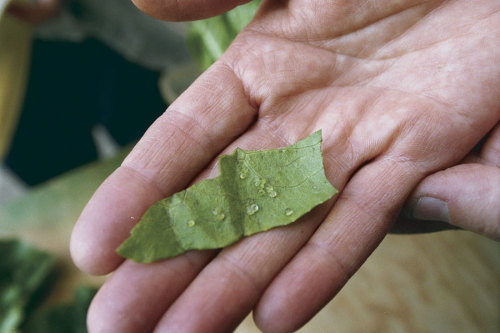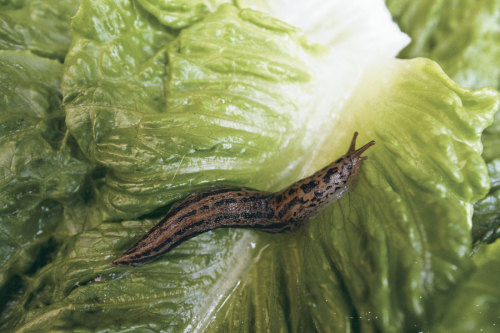
Narrow, silvery trails give them away: snails stalking the garden, using their single foot to glide along on the mucus they secrete. Like footprints, slime trails provide clues to the behavior of these mollusks: where they’re migrating from, where they’re congregating, which vegetation they’re attracted to.
Slugs may or may not provide such handy clues. Like snails, they emerge on damp nights, but they may retreat into the soil close to where they’ve been feeding, leaving no trails to their permanent hideaways in the cracks formed by drying clay soils, in tunnels made by burrowing insects and earthworms, or under rocks and boards—wherever a little dampness remains when the weather turns hot and dry. As the slime trails suggest, the solution to controlling slugs and snails lies in learning about their biology and behavior.
Slugs and snails damage plants by licking them with their radula, a tongue with thousands of teeth that create telltale ragged holes in leaves.
Water management is the key to control
Slugs and snails are closely related to shellfish, and all active phases of snail and slug life require moisture. Snails have shells, of course, and slugs do, too, though theirs are much reduced in size and hidden by the fleshy mantle on their backs. Considering their watery origins, slugs and snails have adapted remarkably well to survival on land. When the air around it or the surface on which it is traveling becomes too dry, a snail can pull its entire body into its shell and seal the opening with a sheet of mucus, which then hardens, forming a secure closure. A snail can remain dormant in this condition for as long as four years.
For much, if not most, of the growing season across the U.S., rainfall, fog, or morning dew will provide enough dampness to encourage slugs and snails, and during dry spells, most gardeners deliberately water their gardens to enable plants to grow. So, in most cases, eliminating moisture altogether is impossible.
Water management comes down to mitigating the effect of rainfall and watering.If slugs and snails are a problem, and you are overhead watering, do so early in the day so plants have a chance to dry off before nightfall, when these pesky mollusks move about and feed. Where appropriate, use underground drip irrigation or leaky hoses that leave the soil surface dry. And build raised planting beds to ensure good drainage of upper soil levels.
When setting out plants, leave adequate space between them so moving air can dry plant surfaces. Reduce the area blanketed by dense ground covers, or relocate dense plantings away from the vegetable patch. Thin out the lower levels of hedges and other shrubs so sunlight and breezes can penetrate and dry the soil surface below.
 |
|
| Be on the lookout for clear, pearl-like slug eggs, pictured, or similar-looking snail eggs. Snails lay eggs in masses averaging 86 eggs each. Slugs lay fewer eggs, which under dry conditions may remain unhatched for long periods. | |
Remove boards and other debris that will retain dampness at the soil surface (unless you are deliberately using them as traps). These provide protected cover during the day and moist places preferred by slugs and snails to lay eggs.
Hand-pick by night, trap by day
Once you’ve done your best to reduce unnecessary dampness and to eliminate hiding places, it’s time to grab a flashlight and go hunting. About two hours after sunset is the right time to hand-pick slugs and snails. Bring along a container filled with soapy water or diluted rubbing alcohol. Captured slugs and snails will drown in soapy water and can be discarded in the compost pile or given a ceremonial burial in the garden, where they will decompose and provide nutrients for the next round of plants.
Hand-picking may seem like an impossibly large job when you start, but by concentrating on the areas in most need of protection and by going out on as many consecutive nights as you can (slugs may not emerge every night), you can make a substantial dent in the local mollusk population.
You should augment your nighttime forays by setting traps and checking them by day. Some particularly attractive plants, such as mint or iris clumps, are traps in themselves. Visit these favored spots regularly and remove all the slugs and snails you find. In addition to these natural traps, there are any number of traps you can fashion. We have found grapefruit halves, placed cut-side down, and overturned, unglazed clay pots to be attractive to slugs and snails. If you use clay pots, you will find that a crushed snail or two left inside will act as an attractant to others as it decays.
Place overturned pots on the shady side of plants so the pots stay cool in the daytime, and leave the ground uneven so snails can find entrance under the rims. Wooden boards or asphalt shingles, kept cool with aluminum foil placed on their top side to reflect the sun, and elevated from the ground with a pebble, also work.
Beer is a well-known attractant for slugs and snails because of the yeast it contains. Commercial yeast mixed with water can be used to the same effect. The trick is to exclude pets and other larger animals from the sudsy trap. Garden writer Gene Logsdon describes an ingenious beer-baited pit trap made from a large coffee can. The entrance is a rectangular opening cut one third of the way down the side of the can. The can is sunk into the ground to the level of the opening. The plastic cap, left on the can, cuts down on evaporation of the beer and prevents larger animals from taking a sip. Just pour in enough beer or yeasty water to reach the level of the opening, and periodically empty out the dead mollusks and refill the trap. It’s up to you how to dispose of any extra attractant.
Barriers reduce your trapping load
If you’re putting energy into a trapping program, it makes sense to create some barriers around the areas from which you are removing slugs and snails. Neither likes crossing dry or caustic materials, so diatomaceous earth, ashes, or sawdust spread on the ground all work as a barrier, so long as they’re kept dry. The catch is that the worst snail and slug problems arise when the weather is wet.
Our solution when gardening in the rainy season has been to place thick sawdust walkways between the plant beds as a partial slug or snail barrier. Over the sawdust, we lay old boards. If the sawdust is thick enough, slugs and snails are reluctant to crawl over it, and they won’t lay eggs under it. The boards work like traps in places where the sawdust is thin. To keep the barrier effective, we regularly add new layers of sawdust.
 |
|
| The slug is a hermaphrodite, with both male and female sex organs. Although self-fertilization has been reported, cross-fertilization is the norm. | |
Because copper is repellent to slugs and snails, it can be used to create very effective and permanent barriers. Permanent, that is, until some vegetation droops or grows over the copper, permitting the mollusks to bridge the barrier. Everything from the most tender and mollusk-prone seedlings to entire planting beds to fruit trees can be ringed with copper strips (typically 2 to 3 inches high) to prevent snail and slug access. The copper oxidizing and turning green does not affect its efficacy. A number of commercial products are now available through catalogues and nurseries. One such product is Snail Barr.
Baits as a last resort
If you feel you must resort to chemical controls, use bait (typically Mesurol or metaldehyde) rather than sprays. Place the bait in containers that allow access only to slugs and snails, and position the containers in concealed locations where they cannot be picked up and played with by children or eaten by dogs.
A simple way to avoid contaminating your soil with bait is to place a small amount of bait in an empty soup can and lay the can on its side. The slugs and snails will enter, take the bait, and die in the can. The dead bodies will attract more slugs and snails. In the kitchen garden, where young vegetable seedlings are the primary slug and snail victims, bait should be needed for no more than one to three weeks, while the seedlings put on some growth. After that, the plants will be less susceptible to slug and snail damage, and you can remove the bait from the garden.
| Learn more: • How to Control Slugs in Your Garden • How to Win the Snail Battle • Meet the Garden Good Guys: Snakes, Toads, Spiders, and Bats |
When all else fails, consider that most of the pestiferous slugs and snails were introduced in the U.S. as a food source. To prepare snails for the table, feed them on lettuce and cornmeal during their final days, to rid them of any grit. Generally they are served smothered in a savory garlic, butter, and wine sauce. Here at last is a chance to eat your pests away!
by Helga Olkowski
April 1999
from issue #20


















Comments
Log in or create an account to post a comment.
Sign up Log in